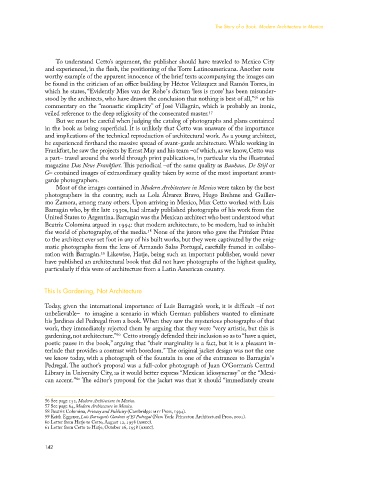Page 142 - Libro Max Cetto
P. 142
The Story of a Book. Modern Architecture in Mexico Cristina López Uribe and Salvador Lizárraga Sánchez
To understand Cetto’s argument, the publisher should have traveled to Mexico City
and experienced, in the flesh, the positioning of the Torre Latinoamericana. Another note
worthy example of the apparent innocence of the brief texts accompanying the images can
be found in the criticism of an office building by Héctor Velázquez and Ramón Torres, in
which he states, “Evidently Mies van der Roheʼs dictum ‘less is more’ has been misunder-
56
stood by the architects, who have drawn the conclusion that nothing is best of all,” or his
commentary on the “monastic simplicity” of José Villagrán, which is probably an ironic,
57
veiled reference to the deep religiosity of the consecrated master.
But we must be careful when judging the catalog of photographs and plans contained
in the book as being superficial. It is unlikely that Cetto was unaware of the importance
and implications of the technical reproduction of architectural work. As a young architect,
he experienced firsthand the massive spread of avant-garde architecture. While working in
Frankfurt, he saw the projects by Ernst May and his team –of which, as we know, Cetto was
a part– travel around the world through print publications, in particular via the illustrated
magazine Das Neue Frankfurt. This periodical –of the same quality as Bauhaus, De Stijl or
G– contained images of extraordinary quality taken by some of the most important avant-
garde photographers.
Most of the images contained in Modern Architecture in Mexico were taken by the best
photographers in the country, such as Lola Álvarez Bravo, Hugo Brehme and Guiller-
mo Zamora, among many others. Upon arriving in Mexico, Max Cetto worked with Luis
Barragán who, by the late 1930s, had already published photographs of his work from the
United States to Argentina. Barragán was the Mexican architect who best understood what
Beatriz Colomina argued in 1994: that modern architecture, to be modern, had to inhabit
58
the world of photography, of the media. None of the jurors who gave the Pritzker Prize
to the architect ever set foot in any of his built works, but they were captivated by the enig-
matic photographs from the lens of Armando Salas Portugal, carefully framed in collabo-
59
ration with Barragán. Likewise, Hatje, being such an important publisher, would never
have published an architectural book that did not have photographs of the highest quality,
particularly if this were of architecture from a Latin American country.
This Is Gardening, Not Architecture
Today, given the international importance of Luis Barragán’s work, it is difficult –if not
unbelievable– to imagine a scenario in which German publishers wanted to eliminate
his Jardines del Pedregal from a book. When they saw the mysterious photographs of that
work, they immediately rejected them by arguing that they were “very artistic, but this is
60
gardening, not architecture.” Cetto strongly defended their inclusion so as to “have a quiet,
poetic pause in the book,” arguing that “their marginality is a fact, but it is a pleasant in-
terlude that provides a contrast with boredom.” The original jacket design was not the one
we know today, with a photograph of the fountain in one of the entrances to Barragánʼs
Pedregal. The author’s proposal was a full-color photograph of Juan O’Gorman’s Central
Library in University City, as it would better express “Mexican idiosyncrasy” or the “Mexi-
61
can accent.” The editor’s proposal for the jacket was that it should “immediately create
56 See page 152, Modern Architecture in Mexico.
57 See page 64, Modern Architecture in Mexico.
58 Beatriz Colomina, Privacy and Publicity (Cambridge: MIT Press, 1994).
59 Keith Eggener, Luis Barragan’s Gardens of El Pedregal (New York: Princeton Architectural Press, 2001).
60 Letter from Hatje to Cetto, August 12, 1958 (AMCC).
61 Letter from Cetto to Hatje, October 26, 1958 (AMCC).
142

